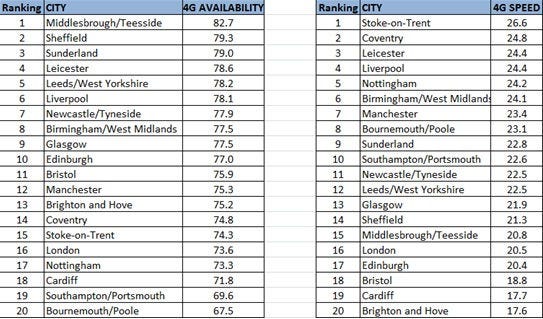4G sucks on the south coast – Which
UK consumer top-tips group Which has teamed up with OpenSignal to look at 4G performance across the country and found it’s worst on the south coast of England.
May 3, 2017

UK consumer top-tips group Which has teamed up with OpenSignal to look at 4G performance across the country and found it’s worst on the south coast of England.
The study looked at 4G signal availability and average 4G download speeds in 20 cities across the country. Inevitably there was a degree of variation, but as you can see from the table below Southampton and nearby cities are the worst for coverage and a bit further east along the Channel coast Brighton is the worst for speed. Taking rural coverage into account national 4G availability is apparently 65%.
“These latest findings underline the need for Ofcom to keep the pressure on mobile operators, so that every part of the country gets a decent service on their mobile phone,” said Alex Neill of Which. “Our mobile phone is central to how we live our lives and that is why it is so frustrating when we can’t access emails or browse the internet on the go.”
The mainstream media has mostly run with the editorial line fed to them by Which, with the standard ‘more must be done’ and ‘postcode lottery’ narrative prevalent. Coverage targets are in place and it seems to be headed in the right direction so the only substantial conclusion that can be derived from these numbers is that 4G is a funny old game. Highly publicised reports like this tend to bring other interested parties out of the woodwork too.
Andrew Ferguson of thinkbroadband.com makes the reasonable point that perhaps we should hold fire on obsessing over 5G until 4G is in better shape. “There are questions that need to be asked about why so much is being invested in 5G research,” he said. “Thinkbroadband itself is already seeing people testing with speeds of 180 Mbps to 200 Mbps (20-30 Mbps upload) on the latest 4G standards. 5G, if deployed at the current mast locations, will give a limited number much faster speeds than that but, to reap the much wider benefits for the Internet of Things, many more mobile masts will need deploying.”
Dr. Konstantinos Stavropoulos of Amdocs Open Network points out this study only paints part of the picture. “While network KPIs are crucial, mobile network operators should keep in mind and base their network deployment/optimization decisions on the actual network experience of their mobile users,” he said. “Albeit complex, focusing on better understanding and managing network experience will be a vital strategy now and as networks evolve on the road to 5G.”
While it’s not immediately clear why the south coast is so hard to cover, London’s low performance is cause for concern. Of course population density will play a part but you would think MNOs would make pleasing their relatively affluent London customers an absolute priority.

About the Author
You May Also Like










.png?width=300&auto=webp&quality=80&disable=upscale)


_1.jpg?width=300&auto=webp&quality=80&disable=upscale)